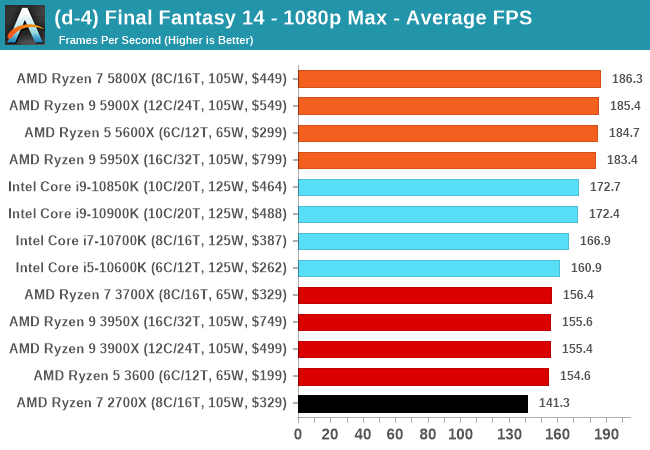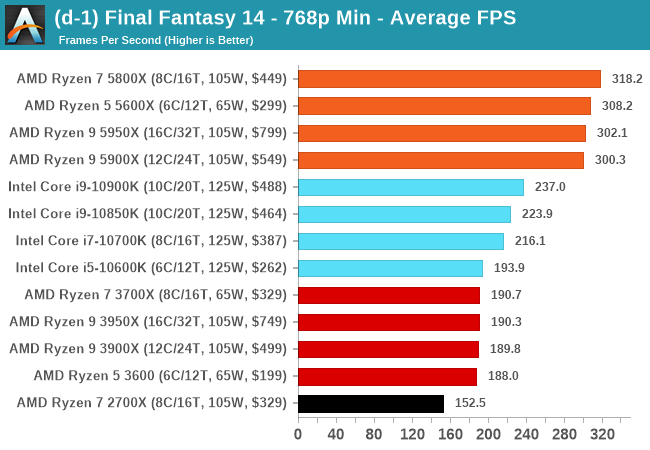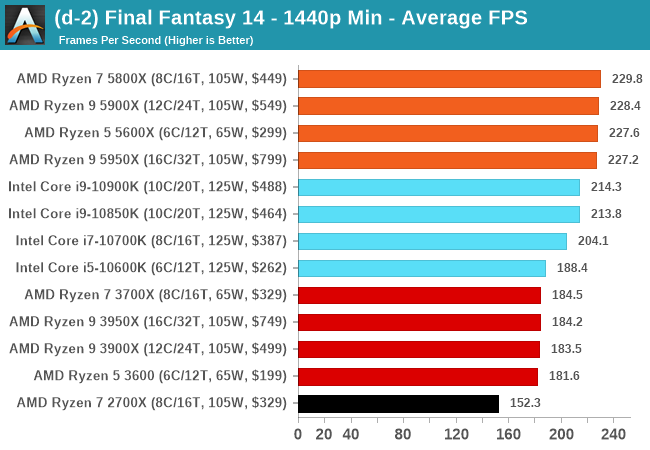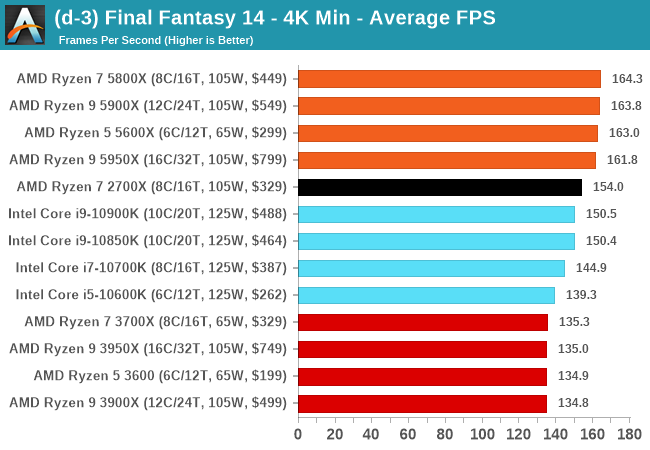AMD Zen 3 Ryzen Deep Dive Review: 5950X, 5900X, 5800X and 5600X Tested
by Dr. Ian Cutress on November 5, 2020 9:01 AM ESTGaming Tests: Final Fantasy XIV
Despite being one number less than Final Fantasy 15, because FF14 is a massively-multiplayer online title, there are always yearly update packages which give the opportunity for graphical updates too. In 2019, FFXIV launched its Shadowbringers expansion, and an official standalone benchmark was released at the same time for users to understand what level of performance they could expect. Much like the FF15 benchmark we’ve been using for a while, this test is a long 7-minute scene of simulated gameplay within the title. There are a number of interesting graphical features, and it certainly looks more like a 2019 title than a 2010 release, which is when FF14 first came out.
With this being a standalone benchmark, we do not have to worry about updates, and the idea for these sort of tests for end-users is to keep the code base consistent. For our testing suite, we are using the following settings:
- 768p Minimum, 1440p Minimum, 4K Minimum, 1080p Maximum
As with the other benchmarks, we do as many runs until 10 minutes per resolution/setting combination has passed, and then take averages. Realistically, because of the length of this test, this equates to two runs per setting.

| AnandTech | Low Resolution Low Quality |
Medium Resolution Low Quality |
High Resolution Low Quality |
Medium Resolution Max Quality |
| Average FPS |  |
 |
 |
 |
All of our benchmark results can also be found in our benchmark engine, Bench.











339 Comments
View All Comments
GeoffreyA - Thursday, November 5, 2020 - link
Battling to load the article for hours, but looks like it's finally working. On page 3 now.GeoffreyA - Friday, November 6, 2020 - link
Thanks for the excellent analysis, AT. Zen 3 has delivered, even more than expected. Brings back memories of the Athlon 64 FX-51 at the top of charts and later the Core 2 Duo, which left K8 dead on the floor. I am impressed by the IPC's having gone up so much but power remaining roughly the same. And, besides the widening, surprisingly conservative, there are a lot of "intelligent" techniques bringing about improvement (reminiscent of the Pentium M in a way). All in all, outstanding work from AMD. The engineers deserve a round of applause.GeoffreyA - Saturday, November 7, 2020 - link
Ian, not sure if I missed it, but what version of Windows does the test suite use? The CPU overload article says 1909. According to Techpowerup, there have been some scheduler changes since 1903 and the difference in performance was a few per cent. for Zen 3. Thanks.https://www.techpowerup.com/review/amd-ryzen-9-590...
mjcutri - Thursday, November 5, 2020 - link
Was pleasantly surprised that I was able to pick up a 5600x from newegg this morning. It'll be a nice upgrade from my i7-3920 that I've been running for 8 years!lmcd - Thursday, November 5, 2020 - link
The thing that's so funny to me is how well Sandy Bridge E has held up. Nearly every board supports PCIe 3.0 and SATA III, quad-channel memory means it's not memory bound, and it clocks up quite well.Obviously performance per watt sucks and it doesn't game as well anymore, but the feature set is way more usable than I'd ever have expected 8 years later.
Spunjji - Sunday, November 8, 2020 - link
It was a really solid platform. Throw in an SSD on PCIe and you wouldn't miss an awful lot from a more modern system, but it looks like that point has finally been reached... 8 years later!lmcd - Monday, November 9, 2020 - link
I wish both Intel and AMD would bring prosumer platforms back. While obviously SLI and XF are dead, PCIe lanes are nice to have and I/O futureproofing is actually impossible anymore.Qasar - Tuesday, November 10, 2020 - link
id just like to see more PCIe lanes. maybe 8-16 more ?Vitor - Thursday, November 5, 2020 - link
The craziest thing is that AMD has a very easy upgrade path with 5nm being avaible.CrystalCowboy - Thursday, November 5, 2020 - link
5 nm, DDR5, PCIe 5, USB4. These are all obvious future developments. They will do a new socket for that; will be interesting to see what they do with that.